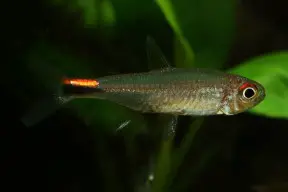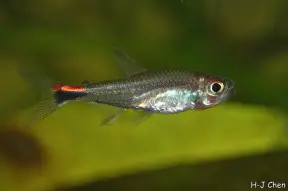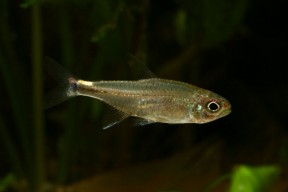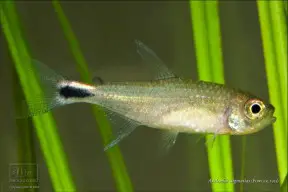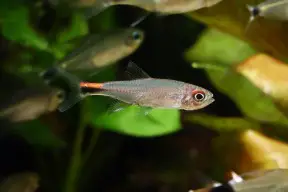Axelrodia stigmatias
SynonymsTop ↑
Hyphessobrycon stigmatias Fowler, 1913; Axelrodia fowleri Géry, 1965
Etymology
Axelrodia: named for American author, publisher, and entrepreneur Dr. Herbert R. Axelrod.
stigmatias: from the Latin stigmatias, meaning ‘one who is branded’, in reference to the dark marking on the caudal peduncle.
Classification
Order: Characiformes Family: Characidae
Distribution
Native to the western Amazon region with confirmed records existing from the rio Madeira and lago Manacapuru complex off the rio Solimões (Amazon) main channel, upstream from Manaus, in Brazil plus the Río Ucayali in Peru.
Type locality is ‘tributary of the Madeira River near Porto Velho, Brazil’.
Habitat
Said to be an inhabitant of blackwater environments, but detailed information is lacking.
Presumably it inhabits smaller, forested tributaries rather than larger river channels.
Maximum Standard Length
15 – 20 mm.
Aquarium SizeTop ↑
Despite its small size minimum base dimensions of 60 ∗ 30 cm or equivalent are recommended for long-term care, though smaller aquaria can be used for breeding.
Maintenance
Best-maintained in a well-structured set-up, ideally comprising a sandy substrate plus some driftwood roots and branches.
The addition of dried leaf litter further emphasises the natural feel and as well as offering additional cover for the fish brings with it the growth of microbe colonies as decomposition occurs.
These can provide a valuable secondary food source for fry and the tannins and other chemicals released by the decaying leaves are also considered beneficial for fishes from blackwater environments. Alder cones may also be used for the latter purpose.
This species seems to do best under fairly dim lighting. You can add aquatic plant species that can survive under such conditions such as Microsorum, Taxiphyllum or Cryptocoryne spp., while floating vegetation, especially Ceratopteris spp., is also useful.
For breeding purposes acidic conditions with negligible carbonate hardness and very low general hardness are required so a reverse osmosis unit or other method of obtaining soft water may need to be employed, and this can be further acidified using phosphoric acid or similar if necessary.
There is no need to use natural peat, the collection of which is both unsustainable and environmentally-destructive.
It goes without saying that this species is sensitive to fluctuating organic wastes and should never be introduced to biologically-immature aquaria.
Water Conditions
Temperature: 20 – 28 °C
pH: 4.0 – 6.5
Hardness: 18 – 90 ppm
Diet
Probably a micropredator feeding on tiny invertebrates and other zooplankton in nature.
In the aquarium it will normally accept dried foods of a suitably small size but should also be offered daily meals of small live and frozen fare such as Artemia nauplii, Daphnia, Moina, grindal worm, etc.
Behaviour and CompatibilityTop ↑
Peaceful with other species but does not make an ideal community fish due to its small size and somewhat specialised requirements
Ideally it should be maintained alone or at most with diminutive, non-aggressive characids and smaller callichthyid or loricariid catfishes.
Though gregarious by nature it is a shoaling rather than schooling species with rival males forming small territories and sparring on a regular basis.
8-10 specimens should be the minimum purchase since the fish will be less shy and display more interesting behaviour.
Sexual Dimorphism
Sexually mature females should appear rounder-bodied than males, however, especially when gravid.
It is unclear whether the differences in colour pattern in newly-imported wild fish (see ‘Notes’) relate to gender or not.
Reproduction
Has been achieved and in a properly-structured, mature aquarium it is possible that small numbers of fry may start to appear without intervention.
The main requirements are soft, slightly acidic water and provision of fine-leaved plants such as Taxiphylum or similar within which the fish will spawn.
Addition of leaf litter is also recommended due to the microorganisms which colonise it as decomposition occurs since these constitute a useful food source for fry.
Once in condition adults spawn on a daily basis so if attempting to breed this species in controlled conditions a pair or male and several females can be placed in a smaller aquarium and removed after a few days with the eggs and fry left to hatch and grow in the spawning tank.
NotesTop ↑
This species is sometimes traded as ‘white star’ or ‘pepper’ tetra.
Axelrodia was proposed as a new genus when it was revealed that the type species Hyphessobrycon stigmatias possessed only a single row of conical teeth and therefore could not be a member of that grouping.
The most recent diagnosis of all three current members appears to be that of Géry (1977) in which A. stigmatias is distinguished from congeners by the following combination of characters: 14-15 anal-fin rays; 7-10 premaxillary and 4-5 maxillary teeth; body depth 4-5 times in SL; suborbital bone large and ‘almost entire’; body silver and yellowish in life; a laterally-extended marking on the caudal peduncle, mostly in the ventral portion; an iridescent spot in the dorsal portion of the caudal peduncle.
It is similar to A. riesei but can be told apart by its more-elongate body (depth 4-5 times, vs. 3.1-3.5 times, in SL), live body colour (silvery yellow, vs. red) and suborbital bone structure (almost complete, vs. reduced).
The third species, A. lindeae, is quite different possessing a greater number of anal-fin rays (22-25, vs. 14-15), premaxillary teeth (15, vs. 7-10), maxillary teeth (8-9, vs. 4-5), and a colour pattern comprising a dark stripe extending from the tip of the snout to below the dorsal-fin, a black line at the base of the dorsal, anal and caudal fins and black primary rays in the dorsal and anal fins.
The colour of the upper caudal peduncle marking vary somewhat though we’re unsure if this is attributable to locality, diet, phenotypic plasticity or something else.
Characiformes is among the most diverse orders of freshwater fishes currently including close to 2000 valid species distributed among 19 families.
This tremendous taxonomical and morphological diversity has historically impaired the ability of researchers to resolve their genetic relationships with many genera remaining incertae sedis.
A further limiting factor has been that in many cases exhaustive study of these on an individual basis is the only way to resolve such problems.
Modern molecular phylogenetic techniques have allowed some headway, although as far as we know Axelrodia has never been included in such a study.
References
- Fowler, H. W., 1913 - Proceedings of the Academy of Natural Sciences of Philadelphia v. 65: 515-579
Fishes from the Madeira River, Brazil. - Géry, J., 1977 - T.F.H. Publications, Inc.: 1-672
Characoids of the World. - Reis, R. E., S. O. Kullander and C. J. Ferraris, Jr. (eds.), 2003 - EDIPUCRS, Porto Alegre: i-xi + 1-729
Check list of the freshwater fishes of South and Central America. CLOFFSCA.
